Muzzle Loading
Go back in time and experience the excitment of shooting from days gone by; these guns are surprisingly accurate for target shooting, and will open up a great new sport that you can enjoy. The term 'Muzzle loaders' covers quite a variety of guns and all use Black Powder or an alternative, such as Pyrodex, as a propellant. There is quite a variety of muzzle loading guns available on the market and include Rifles, pistols and even model cannons. There are also a variety of ways of igniting the propellant - matchlock, flintlock, percussion. The latter method is the most common in use and gives the best reliability. Further down this page you will find some notes on some of the guns available for target shooting.
Muzzle loading Rifles
Muzzle loaders are available in three common designs.
"Historic replicas" are close or exact copies of antiques and are often custom made guns. These guns are usually designed to work and perform just as the originals. Most flintlock muzzle loaders and many Civil War vintage guns are in this category. If the originals shot patched round balls or Minie balls, the replicas function best with the same rounds. These were the first replica muzzle loading gun designs to develop in the 1960's and 70's.
"Replica hunters" represent the second group. These guns tend to have the same general lines as the replicas but beyond that point the similarity ends. Replica hunters have modern adjustable sights, can be easily mounted with scopes, usually possess internal improvements of trigger and lock design, are often fitted with synthetic stocks, and have rifling designs better suited to modern projectiles. The early models stepped away from round ball engineering and introduced the use of heavy lead conicals as projectile choices offering more down range energy. These guns are still popular as choices for buyers wanting to experience historic handling with modern performance characteristics.
The "In-line" class places modern rifle configurations into a muzzle loading package. Except for the fact that it is a muzzle loader, an in-line can look just like any modern rifle. In-line designs have copied the configurations of lever action carbines, tip-up camp guns, modern bull pup military rifles, overly complicated gimmick guns and the striker bolt in-line design. Along with the development of the in-line has been the sabot that uses an undersized projectile enclosed in a plastic sleeve. Bullets used in sabots tend to be jacketed and therefore too hard to be loaded directly into the rifling.
Because it is the rifling or "barrel twist" that dictates whether a gun uses a sabot/conical or patched round ball most effectively, both in-line and side hammer guns can be manufactured to shoot any kind of projectile. Therefore, the only real advantage of one design over the other is personal preference. Do you want a muzzle loader that handles like your modern rifle or do you want a muzzle loader that handles like an old time gun?
Propellants
There are three basic configurations of muzzle loading propellants - traditional black powder, Pyrodex (essentially black powder with cleaning and scrubbing agents added), and so-called sulfur free propellants. The advantage of black powder is that is has a low ignition temperature and is reliable. The disadvantage of black powder is that it is highly volatile and builds up in the barrel and gun mechanism with several shots. It is normal for a shooter to have to run a cleaning patch down the barrel after three or four heavy loads of black powder or the gun becomes virtually un-loadable. It is also highly corrosive and must be cleaned from the gun after each shooting session. Pyrodex has better multiple shot capabilities without using a wiping pass than black powder, a bit higher ignition temperature and is not as volatile. Because Pyrodex contains sulfur, it must be cleaned from the gun after each shooting session as well.
For over a decade various companies have struggled to create a sulfur-free muzzle loading propellant that provides dependable performance and is economically viable to produce. The reason for creating a sulfur-free powder is to substantially reduce fouling traditionally associated with black powder and increase interest in muzzle loading from shooters who believe that cleaning a muzzle loader after each shooting is too much bother. These "breakthrough" propellants have been announced to the world with great fanfare and were usually greeted with a resounding "thud" from muzzle loaders after one season. Most of the products, except for the possible exception of ARCO powder, have proven less than satisfactory. Even though ARCO worked well, there were difficulties with developing a consistent formula and the project was eventually scrapped. Most non-sulfur powders either exhibited poor ignition qualities, uneven performance, or were unhandy to use in the field. Still others never seemed to get to the market place in spite of the fanfare. They lived out there in some sort of propellant nether land promising miracles but never able to survive the demands of mass production. The success record for such products has not been good.
Cleaning and Maintenance
Modern in-line rifles can usually be thoroughly cleaned and reassembled for storage in less than twenty minutes. There are so many good cleaning solutions on the market that it is difficult to name them all. The best advice is to avoid harsh chemicals and rely on solutions that are specifically designed for cleaning muzzle loaders. Guns using Triple Seven, Pyrodex or Black Powder can be cleaned with soap and hot water.
There are two suggestions that are critical to successfully maintaining a muzzle loader. Get in the habit of regularly removing and thoroughly cleaning your nipple assembly. Improper nipple maintenance is the number one cause of ignition failure. Use a naturally "seasoning" compound to lubricate and protect the rifle bore and internal working parts. Examples that come to mind are Natural Lube and Wonder Lube treatment compounds. These compounds will reduce loading difficulty and form a protective coating on the rifling and working parts, much like a well-seasoned cast iron frying pan. Treated guns also store better over long time periods with a minimum of corrosion.
Replica Revolvers
Revolvers are probably the most widely owned type of muzzle loader in the UK. Strictly speaking, of course they are not Muzzle Loaders as they are not loaded from the muzzle of the gun but are loaded directly into each chamber. Anyway, after the handgun ban many former pistol shooters went out and bought a Ruger .22 rifle, an under lever carbine and a black powder revolver. As muzzle loading revolvers are a bit of an acquired taste many of the revolvers are seldom used now, but plenty more are still in regular use, both for plinking and serious competition.
Choosing a Revolver
So, what are the main factors to bear in mind for choosing a revolver. Well, it all comes down to whether you want to shoot competitions or not? If you just want to plink, then buy whatever takes your fancy. Open frame Colts are delightful, Le Mat's are impressive and English Civil War Pistols are monstrous - all great fun. For competition shooting it's altogether different, and we really need to digress here and look at the sort of competitions being shot.
Firstly, there are the traditional Muzzle Loaders Association of Great Britain (MLAGB) matches, which all involve shooting 13 shots in 30 minutes, offhand at a round bull target 25 metres away. To shoot these you need a 'spirit of the original' (i.e. non-adjustable or hammer adjustable sights), which really has to be either a Remington or a Rogers and Spencer in .44 calibre.
Secondly there are the precision rapid fire comps shot two handed at stylised "man type" targets from 25 metres down to ten. These are what used to be called PPI and Service Pistol, but are now called the "Bow Street Runner" and "The Cavalry Officer". There's also a match called "Historic Revolver" which is much the same format, but involves timed reloads between practices. For these, most people use the Ruger Old army, but for pointability, an adjustable sighted Remington or Rogers and Spencer is a better choice. You can of course shoot these matches with a 'spirit of the original', and a well practiced precision shot with one of these will not be seriously disadvantaged.
Finally, there are the oddball matches shot at meetings like the Phoenix, which involve one or two handed shooting at a variety of speeds, either one or two handed. For these, anything will do, but bear in mind that the Ruger Old Army is quite a weight to shoot single handed.
Replica Revolvers - the Guns
So, lets look at the guns which are best suited for serious competition.
The Ruger Old Army is a massive (some would say massively over-engineered) pistol. It's a modern interpretation of the old theme, and is nicely engineered, so it's really a doddle to strip and clean.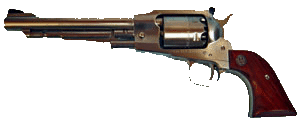 The downside is that it has all the balance of an SA80, comes with too
short a foresight, and has nipples that don't seem to fit any cap ever
encountered. But never mind the cons, buy some "Uncle Mike's" nipples
and for the Cavalry Officer or Bow Street Runner matches it's as a good
a tool as you can get. One other good point is that there's a massive
oversupply of second-hand examples in the UK, so an ad in the back of
Target Sports or the MLAGB journal should provide plenty to choose from.
The downside is that it has all the balance of an SA80, comes with too
short a foresight, and has nipples that don't seem to fit any cap ever
encountered. But never mind the cons, buy some "Uncle Mike's" nipples
and for the Cavalry Officer or Bow Street Runner matches it's as a good
a tool as you can get. One other good point is that there's a massive
oversupply of second-hand examples in the UK, so an ad in the back of
Target Sports or the MLAGB journal should provide plenty to choose from.
Rogers and Spencer revolvers are made by Pedersoli and Euroarms, and probably some others besides. Both the above mentioned firms produce high quality products, but I think the quality control at Euroarms is less good than Pedersoli.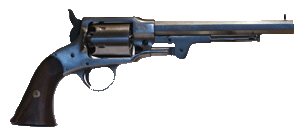 The Euroarms
guns are also a little overpriced,
whereas Pedersoli have dropped by about twenty percent since the
distributor was changed to Viking Arms. Anyway, the Rogers and Spencer
is a fine gun. The one theoretical disadvantage for target shooting is
that the rear sight (or groove) is obscured when the hammer falls. In
practice this doesn't seem to matter and accuracy is excellent.
The Euroarms
guns are also a little overpriced,
whereas Pedersoli have dropped by about twenty percent since the
distributor was changed to Viking Arms. Anyway, the Rogers and Spencer
is a fine gun. The one theoretical disadvantage for target shooting is
that the rear sight (or groove) is obscured when the hammer falls. In
practice this doesn't seem to matter and accuracy is excellent.
Finally, the Remington. This is the classic competition gun and comes in .36 and .44. For some reason the .44 is the almost universal choice for target work. Again, Pedersoli and Euroarms make good examples, but the cheaper end of the Euroarms range can be quite badly fitted.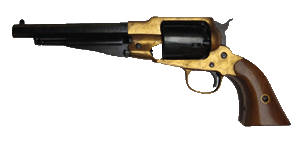 The
Pedersoli guns normally have really fine
triggers right out of the box, whereas the bottom end of the Euroarms
range don't. The one pictured here is an ancient cheap Italian .36
replica with a brass frame - make sure to buy a steel framed one for
serious usage.
The
Pedersoli guns normally have really fine
triggers right out of the box, whereas the bottom end of the Euroarms
range don't. The one pictured here is an ancient cheap Italian .36
replica with a brass frame - make sure to buy a steel framed one for
serious usage.
Of course, if you have pots of money or just want something a little special, you could look at Hege who make superb quality Remington replicas at a price to match.
Whichever you choose, at the end of the day it's all down to personal choice. Remember that some of the cheaper guns can be quite dreadfully fitted, hammers dragging on the frame all the way down and ragged trigger pulls are the order of the day, so buying quality does pay. At the moment Pedersoli offer the best value for money, particularly if your local dealer's prepared to haggle; and why shouldn't you haggle.
Loading and Shooting
To clear the nipple channels, put a cap on each nipple and discharge them. This is called "capping off", and will make you decidedly unpopular if you do it while people are forward of the firing point and in the case of the Tondu club will certainly lead to disciplinary action being taken against you. When people are forward of the firing point the gun must remain untouched and on the bench at all times. "Capping off" is only allowed after the command to "load and fire" is given - and in MLAGB competitions you mustn't do it during the "make ready" period.
Add a powder charge into one chamber. Traditionally powder flasks have been used, but it's becoming increasingly common to use phials - and at some meetings it's now mandatory. This is probably a good thing as it lessens the chance of a powder flask explosion, and phials are available cheaply enough. As to how much and what type of powder to use, well Swiss No 2 is the popular choice among serious pot-hunters, but any medium powder will work well enough. For Swiss number two, anything between about 15 and 22 grains will work well, and for other medium powders go for 18-24 grains. Anything more than this will just give a bigger bang, but shouldn't do the gun any harm. However, at Tondu, your fellow shooters may well complain about the excessive noise which could lead to disciplinary action, as the club is well aware that it could lead to complaints from the local residents.
Stick a wad on top of the powder and ram it home. This is for two reasons - first to make sure there's no air gap between the powder and the ball, and second to reduce the "jump" between the ball and the barrel when you fire. The experts all say that reducing the "jump" between chamber and muzzle is essential for accuracy, so who are we to argue. Wads work fine, but they're expensive, and they come as either plain or lubed. For comps where you have to reload quickly like in Historic Revolver, they're a good choice, as they're quicker and easier than the alternative, which is to use a filler. You can use virtually anything as a filler, the real trick is to find one which measures easily from a powder flask. All kinds of things have been used from soap powder to semolina and cous-cous to bulgar wheat. There is, of course, the old favourite, a sheet of andrex loo paper, so experimentation is called for.
place a ball on top of the chamber and ram it home. Nothing complicated here. Make sure the ball's a tightish fit and If using a cast ball with a pronounced sprue make sure it's at the front or back.
Repeat for the other chambers. Now, if you haven't used a lubricated wad, fill the chamber mouths with grease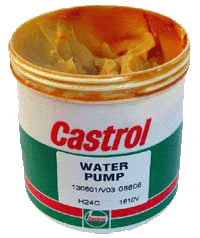 This is generally a good idea as it helps prevent barrel leading and
damps down any loose grains of powder on the front of the cylinder. In
theory it also stops any chance of a flashover where the explosion from
one shot can detonate the charges in the other chambers. In MLAGB
competitions it's mandatory, for all others it's optional. You can use
just about anything for a grease, from vaseline to beeswax and tallow
to Trex. The classic choice in the UK is water pump grease, which is
lime based and actually feels and smells rather nice, and possesses the
significant advantage that it doesn't melt after the first shot. You
can buy special grease guns, or use a lolly stick, or for a light
grease, syringes used for artificial insemination of cattle work quite
well.
This is generally a good idea as it helps prevent barrel leading and
damps down any loose grains of powder on the front of the cylinder. In
theory it also stops any chance of a flashover where the explosion from
one shot can detonate the charges in the other chambers. In MLAGB
competitions it's mandatory, for all others it's optional. You can use
just about anything for a grease, from vaseline to beeswax and tallow
to Trex. The classic choice in the UK is water pump grease, which is
lime based and actually feels and smells rather nice, and possesses the
significant advantage that it doesn't melt after the first shot. You
can buy special grease guns, or use a lolly stick, or for a light
grease, syringes used for artificial insemination of cattle work quite
well.
Finally, cap each nipple and shoot.
Replica single shot Percussion Pistols
Let's look at some of the possible choices of replica percussion pistols. In short, the vast majority of suitable pistols come from the Italian firm Pedersoli. There are some other choices but by and large pedersoli is a sensible choice - the quality is high and the prices are reasonable for what you get.
Replica Percussion Pistols - the Greathead Anderson Under-hammer
There are some competitive pistols not made by Pedersoli, and here's one of them, the Anderson Under-hammer; a very simple hand made English pistol by Jim Greathead. It can be made in any calibre you choose, and is superbly accurate. The low line of the bore in the hand is ideal for accurate shooting, and as the grip can be made in various sizes, it's good for people with smaller hands. There's no set trigger, but the standard pull can be adjusted by altering the tension on the mainspring (you should be able to see the adjusting screw at the back of the grip), which gives a very light pull indeed. On the downside, the finish is not as good as some pistols and there's no half cock safety, but overall a great little pistol. Contact details for Jim can be obtained from the MLAGB.
Miniature Cannons
There is a growing interest within the UK in shooting model cannons and they can be amazingly accurate. Available in calibres from .43 to .75, the most common being .50.
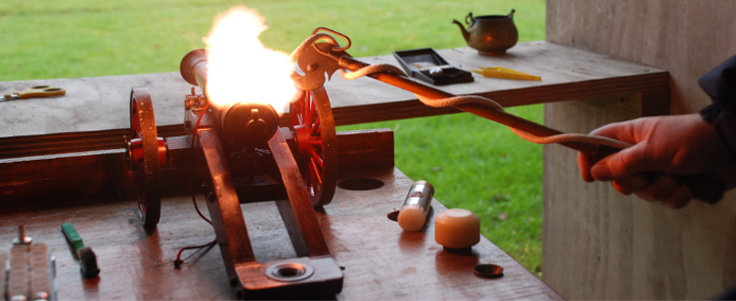
Go back in time and experience the excitment of shooting from days gone by; these guns are surprisingly accurate for target shooting, and will open up a great new sport that you can enjoy. The term 'Muzzle loaders' covers quite a variety of guns and all use Black Powder or an alternative, such as Pyrodex, as a propellant. There is quite a variety of muzzle loading guns available on the market and include Rifles, pistols and even model cannons. There are also a variety of ways of igniting the propellant - matchlock, flintlock, percussion. The latter method is the most common in use and gives the best reliability. Further down this page you will find some notes on some of the guns available for target shooting.
Muzzle loading Rifles
Muzzle loaders are available in three common designs.
"Historic replicas" are close or exact copies of antiques and are often custom made guns. These guns are usually designed to work and perform just as the originals. Most flintlock muzzle loaders and many Civil War vintage guns are in this category. If the originals shot patched round balls or Minie balls, the replicas function best with the same rounds. These were the first replica muzzle loading gun designs to develop in the 1960's and 70's.
"Replica hunters" represent the second group. These guns tend to have the same general lines as the replicas but beyond that point the similarity ends. Replica hunters have modern adjustable sights, can be easily mounted with scopes, usually possess internal improvements of trigger and lock design, are often fitted with synthetic stocks, and have rifling designs better suited to modern projectiles. The early models stepped away from round ball engineering and introduced the use of heavy lead conicals as projectile choices offering more down range energy. These guns are still popular as choices for buyers wanting to experience historic handling with modern performance characteristics.
The "In-line" class places modern rifle configurations into a muzzle loading package. Except for the fact that it is a muzzle loader, an in-line can look just like any modern rifle. In-line designs have copied the configurations of lever action carbines, tip-up camp guns, modern bull pup military rifles, overly complicated gimmick guns and the striker bolt in-line design. Along with the development of the in-line has been the sabot that uses an undersized projectile enclosed in a plastic sleeve. Bullets used in sabots tend to be jacketed and therefore too hard to be loaded directly into the rifling.
Because it is the rifling or "barrel twist" that dictates whether a gun uses a sabot/conical or patched round ball most effectively, both in-line and side hammer guns can be manufactured to shoot any kind of projectile. Therefore, the only real advantage of one design over the other is personal preference. Do you want a muzzle loader that handles like your modern rifle or do you want a muzzle loader that handles like an old time gun?
There are three basic configurations of muzzle loading propellants - traditional black powder, Pyrodex (essentially black powder with cleaning and scrubbing agents added), and so-called sulfur free propellants. The advantage of black powder is that is has a low ignition temperature and is reliable. The disadvantage of black powder is that it is highly volatile and builds up in the barrel and gun mechanism with several shots. It is normal for a shooter to have to run a cleaning patch down the barrel after three or four heavy loads of black powder or the gun becomes virtually un-loadable. It is also highly corrosive and must be cleaned from the gun after each shooting session. Pyrodex has better multiple shot capabilities without using a wiping pass than black powder, a bit higher ignition temperature and is not as volatile. Because Pyrodex contains sulfur, it must be cleaned from the gun after each shooting session as well.
For over a decade various companies have struggled to create a sulfur-free muzzle loading propellant that provides dependable performance and is economically viable to produce. The reason for creating a sulfur-free powder is to substantially reduce fouling traditionally associated with black powder and increase interest in muzzle loading from shooters who believe that cleaning a muzzle loader after each shooting is too much bother. These "breakthrough" propellants have been announced to the world with great fanfare and were usually greeted with a resounding "thud" from muzzle loaders after one season. Most of the products, except for the possible exception of ARCO powder, have proven less than satisfactory. Even though ARCO worked well, there were difficulties with developing a consistent formula and the project was eventually scrapped. Most non-sulfur powders either exhibited poor ignition qualities, uneven performance, or were unhandy to use in the field. Still others never seemed to get to the market place in spite of the fanfare. They lived out there in some sort of propellant nether land promising miracles but never able to survive the demands of mass production. The success record for such products has not been good.
Cleaning and Maintenance
Modern in-line rifles can usually be thoroughly cleaned and reassembled for storage in less than twenty minutes. There are so many good cleaning solutions on the market that it is difficult to name them all. The best advice is to avoid harsh chemicals and rely on solutions that are specifically designed for cleaning muzzle loaders. Guns using Triple Seven, Pyrodex or Black Powder can be cleaned with soap and hot water.
There are two suggestions that are critical to successfully maintaining a muzzle loader. Get in the habit of regularly removing and thoroughly cleaning your nipple assembly. Improper nipple maintenance is the number one cause of ignition failure. Use a naturally "seasoning" compound to lubricate and protect the rifle bore and internal working parts. Examples that come to mind are Natural Lube and Wonder Lube treatment compounds. These compounds will reduce loading difficulty and form a protective coating on the rifling and working parts, much like a well-seasoned cast iron frying pan. Treated guns also store better over long time periods with a minimum of corrosion.
Replica Revolvers
Revolvers are probably the most widely owned type of muzzle loader in the UK. Strictly speaking, of course they are not Muzzle Loaders as they are not loaded from the muzzle of the gun but are loaded directly into each chamber. Anyway, after the handgun ban many former pistol shooters went out and bought a Ruger .22 rifle, an under lever carbine and a black powder revolver. As muzzle loading revolvers are a bit of an acquired taste many of the revolvers are seldom used now, but plenty more are still in regular use, both for plinking and serious competition.
Choosing a Revolver
So, what are the main factors to bear in mind for choosing a revolver. Well, it all comes down to whether you want to shoot competitions or not? If you just want to plink, then buy whatever takes your fancy. Open frame Colts are delightful, Le Mat's are impressive and English Civil War Pistols are monstrous - all great fun. For competition shooting it's altogether different, and we really need to digress here and look at the sort of competitions being shot.
Firstly, there are the traditional Muzzle Loaders Association of Great Britain (MLAGB) matches, which all involve shooting 13 shots in 30 minutes, offhand at a round bull target 25 metres away. To shoot these you need a 'spirit of the original' (i.e. non-adjustable or hammer adjustable sights), which really has to be either a Remington or a Rogers and Spencer in .44 calibre.
Secondly there are the precision rapid fire comps shot two handed at stylised "man type" targets from 25 metres down to ten. These are what used to be called PPI and Service Pistol, but are now called the "Bow Street Runner" and "The Cavalry Officer". There's also a match called "Historic Revolver" which is much the same format, but involves timed reloads between practices. For these, most people use the Ruger Old army, but for pointability, an adjustable sighted Remington or Rogers and Spencer is a better choice. You can of course shoot these matches with a 'spirit of the original', and a well practiced precision shot with one of these will not be seriously disadvantaged.
Finally, there are the oddball matches shot at meetings like the Phoenix, which involve one or two handed shooting at a variety of speeds, either one or two handed. For these, anything will do, but bear in mind that the Ruger Old Army is quite a weight to shoot single handed.
Replica Revolvers - the Guns
So, lets look at the guns which are best suited for serious competition.
The Ruger Old Army is a massive (some would say massively over-engineered) pistol. It's a modern interpretation of the old theme, and is nicely engineered, so it's really a doddle to strip and clean.
 The downside is that it has all the balance of an SA80, comes with too
short a foresight, and has nipples that don't seem to fit any cap ever
encountered. But never mind the cons, buy some "Uncle Mike's" nipples
and for the Cavalry Officer or Bow Street Runner matches it's as a good
a tool as you can get. One other good point is that there's a massive
oversupply of second-hand examples in the UK, so an ad in the back of
Target Sports or the MLAGB journal should provide plenty to choose from.
The downside is that it has all the balance of an SA80, comes with too
short a foresight, and has nipples that don't seem to fit any cap ever
encountered. But never mind the cons, buy some "Uncle Mike's" nipples
and for the Cavalry Officer or Bow Street Runner matches it's as a good
a tool as you can get. One other good point is that there's a massive
oversupply of second-hand examples in the UK, so an ad in the back of
Target Sports or the MLAGB journal should provide plenty to choose from.Rogers and Spencer revolvers are made by Pedersoli and Euroarms, and probably some others besides. Both the above mentioned firms produce high quality products, but I think the quality control at Euroarms is less good than Pedersoli.
 The Euroarms
guns are also a little overpriced,
whereas Pedersoli have dropped by about twenty percent since the
distributor was changed to Viking Arms. Anyway, the Rogers and Spencer
is a fine gun. The one theoretical disadvantage for target shooting is
that the rear sight (or groove) is obscured when the hammer falls. In
practice this doesn't seem to matter and accuracy is excellent.
The Euroarms
guns are also a little overpriced,
whereas Pedersoli have dropped by about twenty percent since the
distributor was changed to Viking Arms. Anyway, the Rogers and Spencer
is a fine gun. The one theoretical disadvantage for target shooting is
that the rear sight (or groove) is obscured when the hammer falls. In
practice this doesn't seem to matter and accuracy is excellent.Finally, the Remington. This is the classic competition gun and comes in .36 and .44. For some reason the .44 is the almost universal choice for target work. Again, Pedersoli and Euroarms make good examples, but the cheaper end of the Euroarms range can be quite badly fitted.
 The
Pedersoli guns normally have really fine
triggers right out of the box, whereas the bottom end of the Euroarms
range don't. The one pictured here is an ancient cheap Italian .36
replica with a brass frame - make sure to buy a steel framed one for
serious usage.
The
Pedersoli guns normally have really fine
triggers right out of the box, whereas the bottom end of the Euroarms
range don't. The one pictured here is an ancient cheap Italian .36
replica with a brass frame - make sure to buy a steel framed one for
serious usage.Of course, if you have pots of money or just want something a little special, you could look at Hege who make superb quality Remington replicas at a price to match.
Whichever you choose, at the end of the day it's all down to personal choice. Remember that some of the cheaper guns can be quite dreadfully fitted, hammers dragging on the frame all the way down and ragged trigger pulls are the order of the day, so buying quality does pay. At the moment Pedersoli offer the best value for money, particularly if your local dealer's prepared to haggle; and why shouldn't you haggle.
Loading and Shooting
To clear the nipple channels, put a cap on each nipple and discharge them. This is called "capping off", and will make you decidedly unpopular if you do it while people are forward of the firing point and in the case of the Tondu club will certainly lead to disciplinary action being taken against you. When people are forward of the firing point the gun must remain untouched and on the bench at all times. "Capping off" is only allowed after the command to "load and fire" is given - and in MLAGB competitions you mustn't do it during the "make ready" period.
Add a powder charge into one chamber. Traditionally powder flasks have been used, but it's becoming increasingly common to use phials - and at some meetings it's now mandatory. This is probably a good thing as it lessens the chance of a powder flask explosion, and phials are available cheaply enough. As to how much and what type of powder to use, well Swiss No 2 is the popular choice among serious pot-hunters, but any medium powder will work well enough. For Swiss number two, anything between about 15 and 22 grains will work well, and for other medium powders go for 18-24 grains. Anything more than this will just give a bigger bang, but shouldn't do the gun any harm. However, at Tondu, your fellow shooters may well complain about the excessive noise which could lead to disciplinary action, as the club is well aware that it could lead to complaints from the local residents.
Stick a wad on top of the powder and ram it home. This is for two reasons - first to make sure there's no air gap between the powder and the ball, and second to reduce the "jump" between the ball and the barrel when you fire. The experts all say that reducing the "jump" between chamber and muzzle is essential for accuracy, so who are we to argue. Wads work fine, but they're expensive, and they come as either plain or lubed. For comps where you have to reload quickly like in Historic Revolver, they're a good choice, as they're quicker and easier than the alternative, which is to use a filler. You can use virtually anything as a filler, the real trick is to find one which measures easily from a powder flask. All kinds of things have been used from soap powder to semolina and cous-cous to bulgar wheat. There is, of course, the old favourite, a sheet of andrex loo paper, so experimentation is called for.
place a ball on top of the chamber and ram it home. Nothing complicated here. Make sure the ball's a tightish fit and If using a cast ball with a pronounced sprue make sure it's at the front or back.
Repeat for the other chambers. Now, if you haven't used a lubricated wad, fill the chamber mouths with grease
 This is generally a good idea as it helps prevent barrel leading and
damps down any loose grains of powder on the front of the cylinder. In
theory it also stops any chance of a flashover where the explosion from
one shot can detonate the charges in the other chambers. In MLAGB
competitions it's mandatory, for all others it's optional. You can use
just about anything for a grease, from vaseline to beeswax and tallow
to Trex. The classic choice in the UK is water pump grease, which is
lime based and actually feels and smells rather nice, and possesses the
significant advantage that it doesn't melt after the first shot. You
can buy special grease guns, or use a lolly stick, or for a light
grease, syringes used for artificial insemination of cattle work quite
well.
This is generally a good idea as it helps prevent barrel leading and
damps down any loose grains of powder on the front of the cylinder. In
theory it also stops any chance of a flashover where the explosion from
one shot can detonate the charges in the other chambers. In MLAGB
competitions it's mandatory, for all others it's optional. You can use
just about anything for a grease, from vaseline to beeswax and tallow
to Trex. The classic choice in the UK is water pump grease, which is
lime based and actually feels and smells rather nice, and possesses the
significant advantage that it doesn't melt after the first shot. You
can buy special grease guns, or use a lolly stick, or for a light
grease, syringes used for artificial insemination of cattle work quite
well.Finally, cap each nipple and shoot.
Replica single shot Percussion Pistols
Let's look at some of the possible choices of replica percussion pistols. In short, the vast majority of suitable pistols come from the Italian firm Pedersoli. There are some other choices but by and large pedersoli is a sensible choice - the quality is high and the prices are reasonable for what you get.
 |
 |
| Pedersoli
Mang in Graz A superb target pistol with single set trigger and delightful balance. |
Pedersoli
Kuchenreuter The top of the Pedersoli range, superb in every respect. |
 |
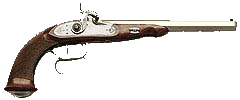 |
| Pedersoli
Carleston With the low barrel line, adjustable trigger and adjustable sights it should be very competitive indeed. |
Pedersoli
Le Page For many years Pedersoli's top pistol. Very commonly seen on the firing line at competitions, and by no means outclassed by the newer Pedersoli offerings |
Replica Percussion Pistols - the Greathead Anderson Under-hammer
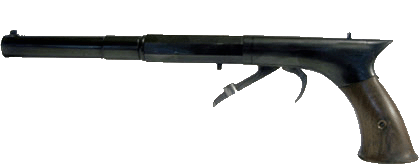 |
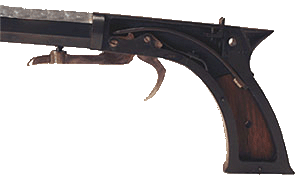 |
There are some competitive pistols not made by Pedersoli, and here's one of them, the Anderson Under-hammer; a very simple hand made English pistol by Jim Greathead. It can be made in any calibre you choose, and is superbly accurate. The low line of the bore in the hand is ideal for accurate shooting, and as the grip can be made in various sizes, it's good for people with smaller hands. There's no set trigger, but the standard pull can be adjusted by altering the tension on the mainspring (you should be able to see the adjusting screw at the back of the grip), which gives a very light pull indeed. On the downside, the finish is not as good as some pistols and there's no half cock safety, but overall a great little pistol. Contact details for Jim can be obtained from the MLAGB.
Miniature Cannons
There is a growing interest within the UK in shooting model cannons and they can be amazingly accurate. Available in calibres from .43 to .75, the most common being .50.

